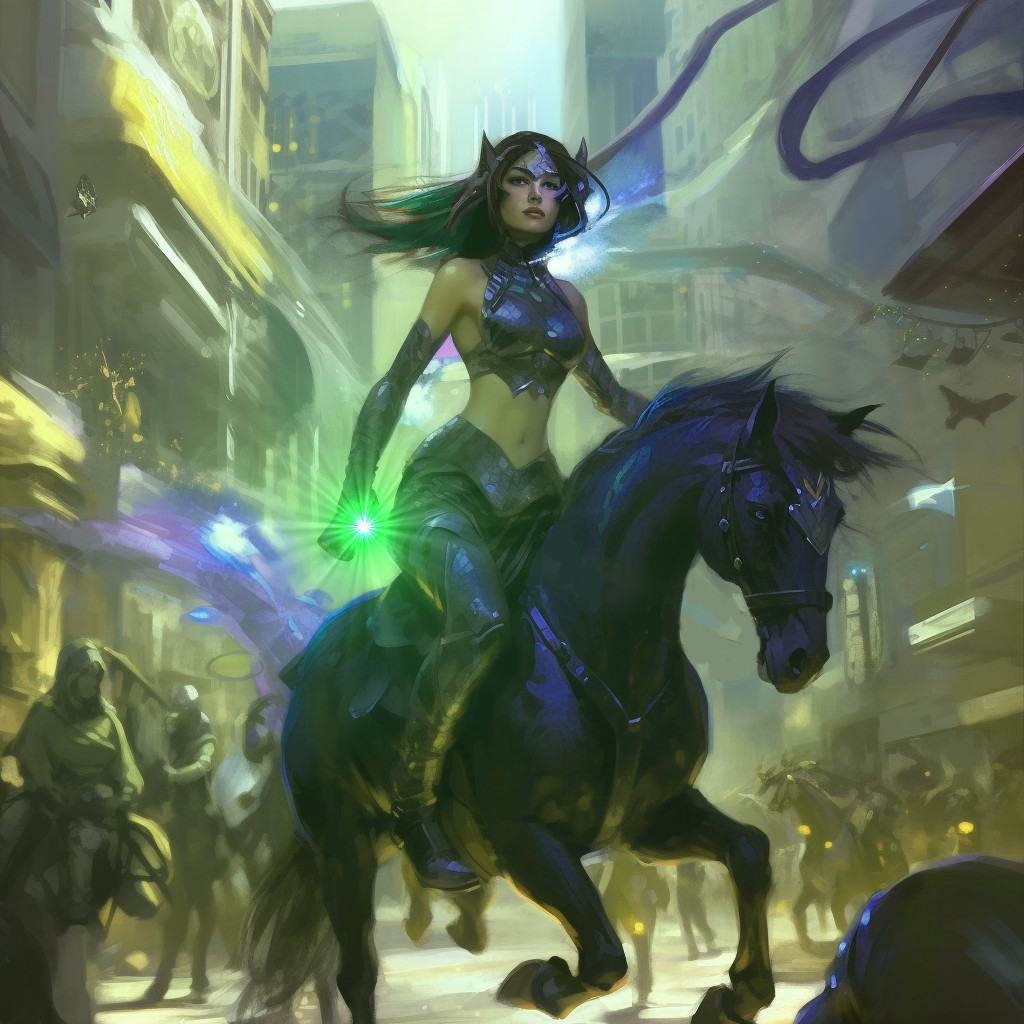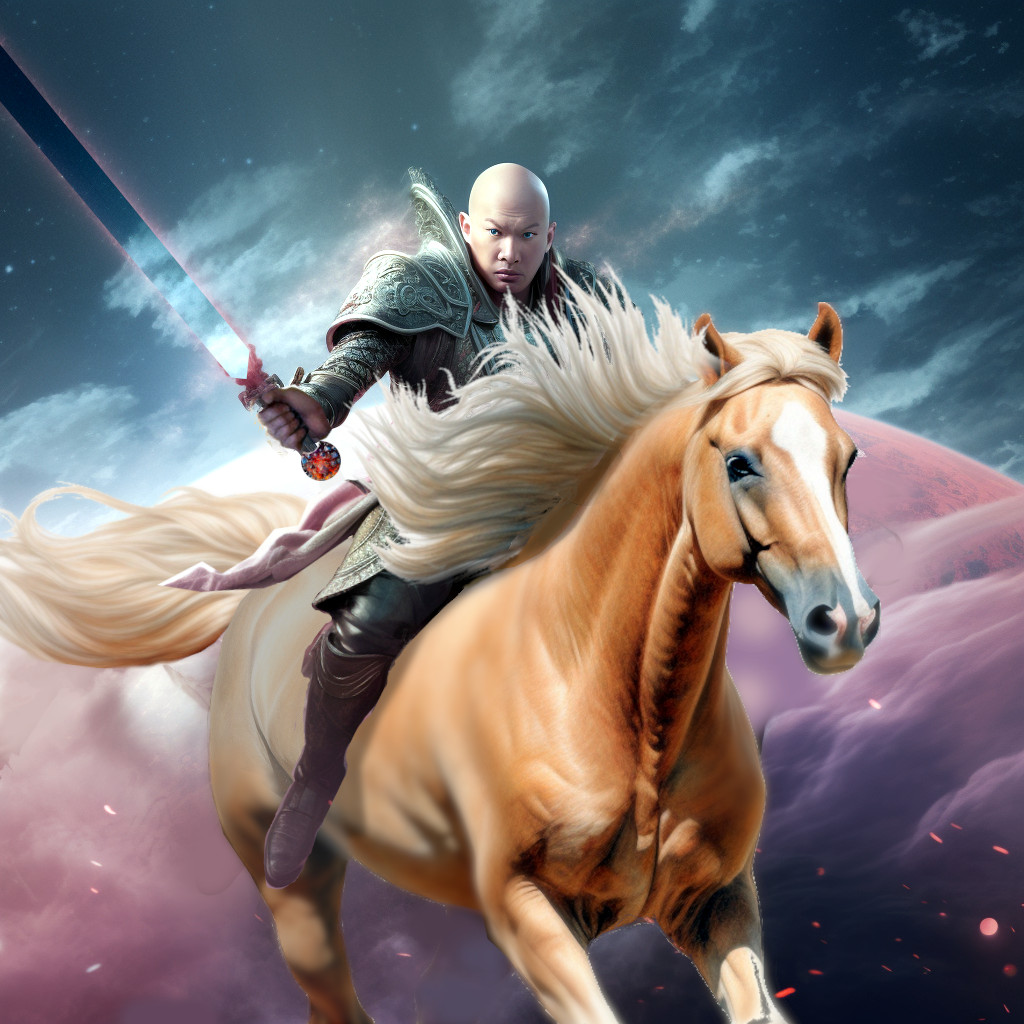History of the Mindsea Empire | ||
The Dispersal | ||
Kokkiro rode the white stallion up the Stairway of Ice. |
At a time when Earth scientists were on the verge of discovering the Deep, a disaster forced humans to flee their homeworld and colonize the galaxy. Earth's leaders formed a temporary connection with a Deep-level phenomenon that transported the refugees across huge stretches of space and time. That is why, although the Empire will arise a million years in our future, the history of human settlement on its planets is far shorter than a million years—only a score millennia on average. Civilization regressed after the Dispersal, as the "transplaneted" humans spread through the galaxy could not return to their origins or communicate with other human settlements. Memories of the Dispersal became myth, the story of Kokkiro, King of Earth, leading his people up the Stairway of Ice. Patternists know that every moment in time splits into as many alternative pasts as alternatives futures, but the story of Kokkiro and the Stairway of Ice is the alternative imperial citizens choose to enshrine. The colonists who followed in Kokkiro's footsteps took with them the genetic codes for all Earth's life-forms, both living and extinct, and seeded their new homes with familiar flora and fauna. The human mind and body remained largely unchanged on many colonized worlds, so although new languages and customs evolved, a basis for eventual reunification remained. | |
The Founding | ||
Attequol navigated interstellar space as he had the seas of his homeworld. |
Attequol was born on a small island on the planet Tywoshak. Although his people were simple fishermen, Tywoshak was a technologically-advanced world that had antiaging genes and universal education. Theirs was a trading world, and Attequol was so impressed by the interplanetary merchants who visited that he built his own ship to follow them. Attequol was gifted with the ability to perceive Deep-level forces and to design equipment that made use of those forces. He sailed the universe-generating waves of the Deep as he had sailed the ocean of his native world. He is credited with inventing the science of Patternistics. His mindpowers caused Attequol to be called the first mindsea, although historians feel that Kokkiro must also have been a mindsea. Attequol had a transforming vision. He foresaw that, just as the myriads of islands on the Tywoshakian ocean were united under one government, the inhabited planets scattered across the ocean of space might be united. He set out on a mission of conquest. Most of the planets he visited were primitive compared with Tywoshak, but even the more advanced peoples could not withstand the patternistic weapons Attequol had developed. Within the course of a few millennia, he forged an empire consisting of three thousand and ten planets. | |
The Patternistic Theocracy | ||
Aturon's sword was to shoot out fireworks when he returned. |
Attequol ruled his peaceful empire for almost five hundred years. Then he vanished. As the years passed, histories traced back to the moment of his disappearance multiplied. Some maintain that he died aiding citizens during a disaster. Others say that he ascended the Stairway of Ice and never returned, just as Kokkiro had. Attequol's son, Aturon, was supposed to take over the reins of empire, but he preferred to hunt planets, and vanished for millennia. A magnificent patternistic detector was constructed at the galactic capital, meant to light up brilliantly when Aturon returned, but it lay forgotten long before that event occurred. A theocracy was established, centered around the galaxy's absent gods—Attequol and Aturon—and the patternistic technology that had melded the empire. Holy Emperor Skresk, a woman who rose from obscurity to seize control of the galaxy, guided the theocracy during its first millennium, impressing upon the people of every planet that they must be pious and worship her as the representative of the absent gods in order for their technology to continue to work. Her successor, Holy Emperor Skeorlian, was a mindsea like Skresk. Even more narcissistic, he tried to replace the ancient emperors as the galaxy's primary god. | |
The Patternistic Mindsea Empire | ||
The Return of Aturon | ||
Aturon traveled in his Deep-level ship, Amber Sun. |
Aturon returned at last to the capital after a voyage that had seemed much shorter to him in the Deep, as far removed from ripples of time as creatures of the abyss are removed from disturbances on the ocean's surface. He put an end to the false piety. But he did not enjoy the responsibilities of governing, and departed once again for other galaxies. | |
Revolution of the Shadowfolk | ||
Quokisa was depicted as a thief of soul-gems. |
In 6,442, Quokisa, a small-time thief who had acquired a soul-gem splinter and developed mindpowers, led an uprising of marginalized citizens and toppled the old priesthood. She bolstered her claim to the throne with the story of being Aturon's longlost granddaughter. She set about sneaking other soul-gem splinters away from the aristocrats who had hoarded them. These splinters were conduits of Deep-level force that had been forged by Attequol and Aturon, and the Deep-blind priests were unable to make use of them, though they denied others their use. It was Quokisa's dream to rediscover the secrets that had made the early empire prosper. She forged a new soul-gem to counter the old soul-gem worshiped by the priests. Hers was called the "Shadowfolk Soul-gem." Her efforts to make her chosen history prevail were thwarted by remnants of the old theocracy, who called her requisitioning of the ancient artifacts piratical and supported the return to power of Skeorlian. The War of the Soul-Gems ended with Skeorlian triumphant. Before she fled the capital, Quokisa shattered her soul-gem, and its splinters were lost. | |
The Evolved Plutocracy | ||
Consulting the congress of humans and animals. |
In 10,971 a mindsea named Tseorue rose from obscurity when she defeated Skeorlian in a mind-duel and took the throne. She did away with the state religion, instead emphasizing galactic productivity. A financial genius, she tapped previously unused resources, putting the galaxy's animals to work alongside its human citizens. Despite a couple of setbacks, including one thousand-year banishment, Tseorue's power structure controlled the empire into the Twenty-First Millennium, as vast corporations run by her favorites arose and slowly consolidated positions controlling all of the commerce in the empire. The corporations remained long after Tseorue's final overthrow in 16,483. | |
The Doubting Theocracy | ||
Ashia built monuments to herself. |
Holy Empress Ashia, who took power in 20,973, was the longest continuously-serving galactic emperor. During her interminable reign, she wrested control from the corporations and invested it in organs dedicated to her worship. Her dogma doubted the divinity of ancient mindseas, instead pointing out the present and practical (herself) as the true omnipotence in citizens' lives. She had no mindpowers, and towards the end of nearly ten-thousand years on the throne her personality disintegrated in the process of crystallization that affects most citizens despite antiaging. Long habit kept the theocracy running smoothly for another two hundred years after her death. | |
The Unfused Plutocracy | ||
The Templefall | ||
Rathax milked the multiverse. |
Emperor Rathax, who took the throne in 30,464, was inspired to use mathematics creatively in order to increase the Empire's wealth. Other rulers had tried to maintain a unified timeline across the many imperial worlds, but Rathax reasoned that if one allowed the timelines to proliferate freely, income could be collected from all of the multiverse. Rathax tried to reduce all of the timeline-fusing towers Attequol had built, and was crushed by a falling stone. | |
The Era of Extension | ||
Hosto kept credits flowing. |
Rathax was succeeded first by his imperial major and later by descendants who called the problem of poor communications the solution to economic woes. A series of these weak emperors controlled the galaxy until the dawn of the Thirty-eighth Millennium, and kept the credits flowing. The last great ruler of the plutocracy, Empress Hosto, scion of a lesser family, sought still more powerful and destructive equations to draw on the fundamental patterns of the universe. "Extend to the unknown," she urged the stewards of her monetary schemes. "Extension" was one of the patternsitic rules of concept-formation taught at mindsea academies, and her pronouncements thrilled the Common Mind with their clarity and precision. She reigned for nearly a thousand years. | |
The Spacious Mindsea Empire | ||
The Ziponist Era | ||
Zipo excelled in duels on horseback. |
In 37,889, Emperor Zipo, a son of old Empress Ashia, swept into power to begin a reign that would extend, off and on, to the first year of the Forty-Seventh Millennium. Zipo cast aside the reverence for mathematics and the focus on milking the timelines in favor of an old-fashioned warlike and expansionist philosophy, and the Empire shifted from realms of time to realms of space. The galactic throne had not been won in a mind-duel since the Evolved Plutarchy, but all that changed with Zipo. He paved the way for ambitious men and women to advance, not through family connections, but by Deep-level fighting prowess. They called themselves the Ziponists. Zipo himself was defeated and dethroned on four occasions, but managed to effect a comeback three times before the humiliation of his defeat by the inferior mindpowers of soon-to-be Empress Tleg. The Ziponist movement lived on long after he was gone. | |
The Reversionist Era | ||
Roxun liked to disguise himself as a beggar. |
Imperial Major Xegle, ever seeking to solve the mystery of why she resembled ancestral human stock rather than her parents, engineered a supreme duelling emperor from wild hominid genes. Emperor Roxun triumphed in thirty-one mind-duels and held onto the throne for two thousand years. Dying undefeated, he was followed by his and Xegle's great-granddaughter, Svalmips, who herself regained the throne after her defeat by an unknown mind-duellist. | |
The Transaxial Meritocracy | ||
The Blooming | ||
Besi strove to remake the empire as a garden of delight. |
In 64,910 Mindsea-empress Besi, who came from a long line of Greenists, patternists, and temporal engineers, took power. She cleared away the old engines of war and instituted a meritocracy. Her plan was to allow the most energetic and creative imperial citizens to come to the fore. She hoped to encourage a wide spectrum of improvements, in the arts and architecture as well as science. | |
The Wake of Besi | ||
Trero built transaxes for interplanetary travel. |
In 65,530 Besi was assassinated, and the son of Svalmips she had overthrown returned. But Emperor Trero had been softened by Besi's reforms, and had lost his taste for violence. Instead of mind-duels, Deep-level horse races determined the winners of important positions throughout the empire. The seven millennia of Trero's rule saw increasing benefits of patternistic technology, including transaxes that guided interstellar travelers across the timelines. Trero was succeeded by a son who continued his policies for another fifteen hundred years. During the Meritocracy's last millennium, during the reign of Empress Steolfeen, positions of power were more and more often acquired by military force or bought. Those in power had neither the knowhow nor the willingness to maintain the techology upon which society depended. Besi's soul-gem, the last echo of her personality, was destroyed by Ziponists, and the farfling towers, no longer serving any purpose, fell, one by one. | |
The Cataclysmic Theocracy | ||
The Trembling Time | ||
Quazi was terrified by the vastness of the universe. |
In 76,558, Imperial Major Tetre, weary of the hypocrisy of imperial life, transformed the meritocracy into a theocracy dedicated to the worship of the god who was punishing humanity with crime, violence, and entropy. Requiring a holy emperor who would believe in her vision of a terrrible god, she used the DNA that had produced Roxun to create Empress Quazi. Quazi passed her memories of primieval cataclysms to Kahee, her son with Tetre. But neither Quazi nor Kahee could bear sitting on a throne, so Tetre had to find others to play that role in the theocracy. | |
The Za Leit Era | ||
Za Leit commanded nature's destructive forces with her mind. |
In 78,529, a mindsea named Za Leit ascended the throne with her expanded take on Tetre's vision. She declared that existence was a battle between the human will and the uncaring, often dangerous forces of nature. She emphasized the need for masters of the universe to become strong, to use force against force. She herself provided an example of masterful will, reshaping spacetime itself with her vision. She pointed out, triumphantly, that mindseas draw their vitality from the same Deep-level realm that generates universes, and thus are immune to crystallization. Unlike old Empress Ashia, she could reign forever. The following millennia witnessed the back-and-forth struggle between Za Leit, the unleasher of cataclysms, and galactic business interests that craved less destruction of their resources and customers. Za Leit was overthrown, but as she was the only one who understood the Deep-level passages she had carved out between imperial worlds, the victors did not dare put her to death. Twice she broke free from supposedly secure prisons to regain the throne. Finally, in 86,206 she was imprisoned for the last time as Tlooshet, a great-granddaughter of Empress Quazi, took the throne. Za Leit died two millennia later during the reign of Holy Empress Zupa. | |
The AIGGLE Regime | ||
No one understood the workings of AIGGLE. |
When a financial genius named Zupa ascended the throne in 87,630, the Empire suffered from serious communications troubles. All the wonderful transaxes of the Meritocracy were long gone, and the Deep-level passages of Za Leit that had replaced them had been lost as well. Zupa got to work and developed a system she called the Autonomous Intragalactic Greater Link Energizer. AIGGLE solved the communications problems, but no one except Zupa understood how it worked. She had a glowworm-free office far out in the desert where she would go from time to time with a few officials to adjust the system. None of the people who went there with her could recall any details about AIGGLE, but no one questioned the Empress, because it worked. Secure with her secret, Zupa reigned unchallenged for four-and-a-half millennia, until a newly appointed major accused her of misuse of mindpowers, and she was tried and executed. | |
The Temporal Aristocracy | ||
later known as the Decadent Epoch | ||
Riemis was master of time and space. |
Major Riemis Horl Draxurant bred, trained, installed and removed emperors for seven millennia after disposing of the last Holy Empress, while he used the galaxy as a laboratory for his time experiments. His mastery of the timelines allowed him to banish rivals and detractors into other histories or to isolate them in worlds with spatial, temporal, or patternistic walls, while his chosen lieutenants enjoyed the benefits of his inventions and wielded great power over the common people of the planets they governed. In the end, one of his experiments got out of control and caused his downfall. | |
The Spacious Aristocracy | ||
The Contested Era | ||
Destructive wars made the mindseas unpopular. |
As the empire reached its hundredth millennium, mindsea-emperors produced by the previous era's breeding program waged fierce battles for control of the galaxy, sometimes laying waste to entire planets. The secrets of temporal and patternistic engineering that Horl had uncovered were again lost. In response to the violence and chaos, a movement grew to exclude the wild genes Horl had introduced in his experiments and return the galaxy to the supervision of the empire's ancient and tested bloodlines. | |
The Age of Illumination | ||
Katora dreamed of nurturing a future leader. |
Daughter of the Circle Empress Katora led the way with her vision of an era where mindseas would provide beneficent guidance for all of the galaxy's peoples. Tracing her ancestry back to the Empress Besi, she felt something grand and mysterious flowing through the generations. There was a special magic in her bloodline, as if tragic Besi's hopes and dreams vibrated within all of her cells. She vowed to pass the love and wisdom that had been entrusted to her on to her own children, who would have the responsibility for guiding the galaxy one day. | |
The Fluidity of History
Because imperial travel and communications cross timelines, and mindseas engage in temporal engineering, only the broad outlines and the most pivotal events of galactic history remain stable as the empire's past and future are rewritten. Less vital individuals and events undergo constant flux, and even planets may change or vanish altogether.


















